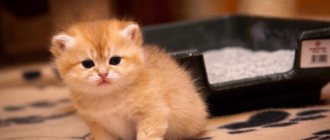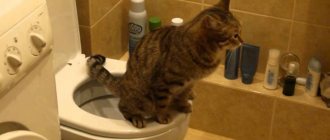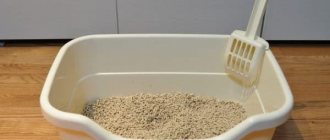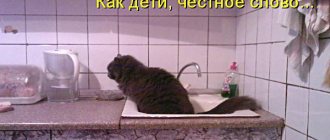When a kitten appears in an apartment, most people teach it to use a litter box, which involves constant cleaning, time and material costs. Therefore, many breeders initially raise their pets differently.
At first glance, it seems that only a trainer can train a cat to use the toilet. In fact, you can do this yourself, just be patient, treat your animal with love, and soon your four-legged friend will please the owner with his first successes.
What benefits does this give?
Happy is the owner whose cat wants to go to the toilet on its own and does not need to be taught to do so. But more often the cat flatly refuses to go there and then the question arises: is it possible to train the cat to use the toilet.
This process requires patience and gradual progress through all stages. There is no need to rush here, otherwise the cat may be frightened.
Ultimately, this provides the following benefits:
- Cat care will be minimal and will be reduced to flushing the toilet
- The need for a tray disappears, and therefore there is no longer any need to fill and clean it
- The tray always gets in the way, but if the pet is toilet trained, this problem ceases to be relevant
- This eliminates the need for cleaning
- The problem of indoor odor is no longer relevant
Why doesn't my cat go to the toilet?
If you have tried all the ways to train a cat to use the toilet, but the stubborn animal continues to defiantly refuse to go to the toilet using this accessory that is incomprehensible to it, do not be discouraged and better give up your idea.
Why doesn't she want to sit on the toilet? There can be many reasons:
- uncomfortable to jump;
- cannot stay on the toilet lid;
- afraid of the noise of water or a drain barrel;
- it simply shows its character, which is quite predictable for the wayward and independent cats of some breeds.
Who should be trained and who should not?
No matter how beneficial it may be, in some cases it is better not to do this, namely:
- If the cat is large and leads a sedentary lifestyle. They don't have as much dexterity as some, so they risk falling and getting hurt.
- You should absolutely not try to train a cat if she is pregnant, she has no time for it
- It’s also impossible to train an old and sick cat
By and large, all pets are equally trainable.
- But it is better to refrain from training small kittens, as this can result in injury or even death.
- It is worth training only animals that are old enough to have used a litter box before without any problems.
- And you will have to refuse this option if the owner has more than one pet.
- Sometimes, animals themselves show interest in the toilet and even try to use it, but their independent attempts may end in failure.
There are cases when a cat, unable to stand on the toilet, fell into the water and after that flatly refused to approach it.
Wrong opinion
Experts say that it is necessary to accustom your pet to the toilet from infancy, because it is impossible to accustom an adult cat. They also say that a litter box trained kitten will not change its habit. This is incorrect for several reasons:
- for the first six months of a kitten’s life, you cannot accustom it to the toilet, because it will not be able to hold steady, it will get scared and will avoid this place;
- first, accustom the pet to the tray;
- Even an adult cat can be toilet trained.
Each animal has its own character, one is easy to train, the other, due to fear and apprehension, needs more time to get used to. The approach to each kitten should be individual, but the principle of training is no different. First, you need to teach your pet to masterfully use the litter box.
Studying time
Cats with a calm, balanced character master the toilet in about three weeks.
- But if the cat has extremely violent behavior and is afraid of its own shadow, this will take longer.
- Sometimes the process in such cases lasts from two to four months.
- The character and behavior of each cat is individual, so you should not rush, so as not to overdo it.
How long will it take
The guarantee of successful acquisition of a useful skill is slowness in action.
Rudeness and punishment are unacceptable, only a gentle approach.
It is possible to train emotionally stable pets in 3-4 weeks. Animals with a more capricious character will take a little longer to adjust - approximately 8-9 weeks.
Cats, like people, are individuals. The owner, who knows his ward better than anyone else, must feel when it is better to pause the training process so as not to ruin everything. According to reviews of some cat lovers, even stubborn purrs were able to make friends with a porcelain friend in 3 months. Therefore, you should be patient.
A device for teaching a cat to pee in the toilet
To do this, you can use a special mesh insert. You need to cut holes along the edges and then glue them to the toilet seat. There are a lot of similar devices in pet stores. They are different in terms of appearance, but the same principle of operation.
The idea is to install the tray directly on the toilet. The main thing is not to clean it right away, because after this cats often refuse to go to the toilet and begin to relieve themselves in other places.
Special attachments
Often difficulties arise at the final stage of training, when the tray needs to be installed on top. The box may not be the right size, making it difficult to jump into. It is more rational to use special attachments sold in pet stores.
With the help of such a pad it is much easier to teach your pet to go to the toilet
The principle of operation of the system is to sequentially expand the hole in the middle until a regular lining is obtained. They come in 2 types:
- plastic container fixed to the toilet. It already contains markings for cutting out circles of different diameters. Start with the smallest one and increase it by one contour every 5 days. When the cat confidently begins to stay on the rim and recovers, the nozzle is removed;
- a system that includes several rings of different diameters, inserted into each other according to the pyramid principle. It is enough to periodically remove one ring at a time to expand the hole in the center.
More advanced designs are also sold, equipped with folding legs (for gradual lifting) and retractable curtains. With their help, the process of training a pet will become as simple and convenient as possible.
When choosing a system, be sure to take into account the weight of the animal. Large representatives require durable plastic to withstand heavy loads.
We train a cat to use the toilet at home
Some people buy cat litter for their pets with silica gel filler, and the cat masters it without any problems. But after some time, many people get tired of the fact that balls constantly stick to their feet, rolling around throughout the apartment and the need to endlessly vacuum.
If you buy wood filler, it also sticks to your feet. Then something needs to be changed and the question arises of how to accustom an adult cat to the toilet.
- In this case, you will need to buy a special device for the toilet. This device consists of two parts.
- First you need to pour cat litter into the second part of it, you can add cat litter already with the smell of a cat so that the cat gets used to it faster and put it on the floor.
- The cat follows its scent, gradually gets used to this toilet, and after a week or a week and a half, when it has mastered this potty well, it can be placed on the toilet.
- Next, you will need to gradually cut out the holes so that the cat begins to see that there is water inside. One hole takes 5-7 days.
Ultimately, silica gel balls remain on the last circuit, that is, the cat does not immediately see the state of this vessel, but gradually gets used to seeing the entire toilet bowl.
There are no problems, there is no smell, nothing sticks to the feet, a very simple device that saves the owner’s nerves.
Training a little kitten
All cats go to the toilet, which is quite normal and natural. Pets in a private home have unhindered access to the street, where they can freely relieve themselves as needed. Cats living in apartments are provided with a plastic tray, into which a special filler is added that absorbs urine and unpleasant odors.
A cat tray is a very convenient device, but it requires constant care. The owner will have to change the litter and rinse the cat litter every day, which will eliminate foul odors in the house.
The most convenient option is to train your cat to use the toilet. If an intelligent animal gets used to going to the toilet in a real plumbing fixture, the owners can only be proud of their furry friend, who relieves himself independently without creating any problems for humans.
To train an animal to use the toilet, you will need to be patient. The first step is to “introduce” your furry friend to the bathroom. A curious animal will definitely “stick its nose” into an unknown room. Leave her there alone for a while and turn on the tap.
Many cats are afraid of water and noise, so gradually accustom her to the flow of water from the tap and the noise made when flushing the barrel.
When raising domestic cats, the rule is that you need to accustom your cat to everything from an early age! The toilet case is an exception to the rule, and we will now tell you why.
A small kitten will not be able to stay on the toilet. Any fall will cause fear, which will become the first obstacle on the way to your goal. In addition, there is a possibility of falling into the toilet itself, and this is fraught with more tragic consequences.
According to the advice of experienced experts, it is better to start toilet training a cat from 5-6 months of age. For the first time, you will need a tray with filler, which will also be useful in the future for toilet training.
CitiKity simulator
The essence of this simulator is that it includes plastic in the form of a tray and there are 7-8 sections on it. That is, the question of how to train a cat to pee on the toilet can be resolved in 7-8 weeks. This tray should be placed under the baby cat and covered with cat sand, and then left there for a week.
You need to train the cat to jump in there. After a week, you need to cut out the first section - the smallest circle that is in the middle. The cat continues to get used to walking.
- After a week, cut out even more. Eventually, when there are no sections left at all, you will end up with a healthy hole. Thus, the animal learns to relieve itself in the toilet on its own. If you teach it from two months, it takes about a year and a half.
- The instructions say that you can train from 6 months, but the sooner you do this, the better, because the older the cat gets, the more difficult it is to influence him.
- During this time, there will be cases when the cat will go the wrong way, relieve itself in all corners, for which it needs to be punished. This punishment lasts for a week, after which everything is repeated, but patience is important here.
- Teaching a cat to go to the toilet is not an easy job, but at the same time, it is an opportunity to study his habits, character, and behavior.
In the future, the owner will already know that if a cat, for example, rushes around the apartment and meows loudly, this means that he wants it big. If he starts clinging to the carpet with his paws and spinning around the wall, it means that he wants something small.
Let's start with the tray
It is necessary to accustom your baby to the tray from the first days after birth. Kittens have a peculiarity - they defecate immediately after eating. If you are patient and make sure that your baby goes to the toilet immediately after eating for several days in a row, then your pet will not have problems with the toilet in the future.
The cat must be handled carefully, without causing pain. When the kitten has eaten, carefully pick it up under the tummy and take it to the tray. If the kitten crawls out of the toilet without emptying itself, it is returned back. After completing toilet chores, the kitten is praised.
The toilet container is placed in a convenient place; sometimes the kitten itself will determine such a place, trying to empty itself there. Then the tray is gradually moved closer to the toilet room.
First, the cat is accustomed to the sound of water pouring out of the cistern. They do this gradually, drain the water with the door open so that the cat hears the noise from afar, then press the drain in front of the animal. While the water is roaring, they hold the cat in their arms, stroke it, say kind words, and show how the water flows.
Final tips
When a cat learns to relieve itself in the toilet, it will be important to follow some rules:
- Leave the toilet door slightly open so that the cat can pass through without any problems.
- The toilet seat cannot be lowered. The cat should relieve itself without hindrance
It is recommended to create a diet and track when the cat relieves itself after eating. The owner can adjust this mode to suit his schedule.
Benefits of using a toilet instead of a litter box
Why train an animal to use the toilet, when to maintain cleanliness in the house it is enough to regularly change the cat's litter box? On the one hand, this is true. But if you look at the benefits of letting a cat use the toilet, it becomes obvious that this method of organizing a cat’s litter box is much better. It has a number of advantages:
- There is no need to look for a convenient place for the tray so that it does not interfere or catch the attention of guests.
- No unpleasant odor. It is unlikely that the owner will clean up after the cat immediately after filling it, so the presence of an unpleasant odor, albeit temporarily, will always be present.
- Saving time on cleaning the cat litter and regular disinfection.
- Cleanliness – the toilet tray for cats has a very modest size, and no matter how clean the cat is, granules or sand will always be scattered around the tray.
- Money savings - cat litter costs money, and in order to maintain cleanliness in the tray, it is recommended to change the granules as often as possible, and this, accordingly, is a constant waste of money.
And of course, what owner of a mustachioed pet would not be pleased by the enthusiastic cries of the guests watching how the smart cat not only went to the toilet, but also flushed after himself.
Methods
To teach a kitten to use the toilet, two conditions must be met:
- The kitten needs to get used to the litter box.
- The kitten must be over 4 months old and of medium size so as not to drown in the toilet.
If you start training your pet before 8 months of age, you can quickly achieve results. The methods are not suitable for pregnant cats.
Method No. 1 - gradually moving the tray
The method consists of the following procedure:
- The tray is installed next to the toilet. Every week it is raised a couple of centimeters higher. To do this, newspapers, paper, cardboard, and magazines are placed under it. The structure must be reliable and stable so that the pet feels safe on it and can dig around in the pot.
- Next, the tray is moved to the toilet. It's better to do it in stages. First, place it between a stack of papers and the toilet, and after a week place it on the rim. Give the kitten time to get used to it, and then remove the newspapers.
- After the pet has adapted, after 3-4 days you need to put a thick sheet of plastic under the toilet seat instead of a tray, and also sprinkle a handful of bedding on top. The partition must bend under the weight of the animal, but not break or collapse. This is necessary so that the kitten, in an attempt to maintain a comfortable position, transfers its body weight to the toilet seat. Give the kitten a week to get used to this design.
- Next, make a hole a couple of centimeters in the plastic. Every few days, enlarge the hole by 1-2 centimeters. Continue this procedure until the hole is the size of a toilet seat. Afterwards, the kitten must go to the toilet on its own.
Method No. 2 – “Sharp Cat” remedy
The drug is used to train a kitten to use the litter box, but it can also be used to form the habit of going to the toilet. The product has the form of drops with a pleasant smell for animals. For people, the aroma is weak and will not interfere. But cats react to it constantly.
Using drops only will not give the desired result. It is necessary to combine this method with the previous method. The solution is used at the stage of replacing the tray with a plastic sheet. The problem at this stage appears due to the fact that the plastic has an unfamiliar smell (or even unpleasant for the cat). To solve the problem, you need to apply a couple of drops on the sheet itself.
Method No. 3 - special simulators
How to train a cat
How to stop a cat from chewing wires
Kitten doesn't want to go to the litter box
Such simulators include “Citikitty Cat”, “Litter Kwitter”, “Domakot”, and similar designs. Their kit is different, but the principle of operation is the same. The cost of all sets ranges from 750-1000 (for “Citikitty Cat”, “Domakot”) to 2500-3000 rubles (for “Litter Kwitter”) and more.
The main element of the simulators is a tray attachment, at the bottom of which there is a hole with removable rings. These rings allow you to gradually widen the hole in the structure. Its function is the same as the first method described above.
Additionally, the kit includes another tray attachment, which should help you return to the previous stage if problems arise. Sometimes the kit also includes mint, aromatic substances pleasant to cats, a magazine with recommendations on how to use it, as well as a lifting device for changing the height of the tray.
The general principle of operation is the same. The potty is first raised to the level of the toilet with or without the use of a special support device - using a stack of papers. Then the tray attachment is placed on the toilet. At the end, you need to either make holes in the bottom (following the signs), or take out the rings from the bottom, widening the hole.
The scheme for toilet training a kitten is the same.
The advantage of using a special tray is as follows:
- the pet feels more confident on a stable structure, which was specially created for attachment to the toilet;
- The bottom is made elastic, but strong in terms of thickness and flexibility;
- Using a support device, it is easier to place the pot at the desired level;
- sometimes special devices and marks are made in the tray that will make it easier to create holes of the required diameter;
- The last advantage is that the partitions are made strong.
Method number 4 - sprays
However, the problem arises at the last stage of toilet training. The fact is that as soon as you start removing the bedding and making a hole, the kitten may suddenly lose interest in the potty. In this case, the pet will look for other corners that are familiar to it.
To scare away, use special sprays:
- "Smart Spray";
- "Beaphar Catty Home";
- “Ms. Kiss";
- "Himola".
But remember that many of them have an unpleasant odor. The solution quality of the sprays is the same.
Second phase
When the cat litter box is located directly next to the toilet, and the pet goes on it without problems, you can proceed to the second stage - raising the cat litter box to the level of the toilet bowl. To do this, you will need several stands or benches with different heights. Every day the tray should rise 5 cm higher, positioning itself closer to the toilet seat.
The toilet lid must always be open. This is necessary so that the cat gets used to this type of toilet. Naturally, a cat's curiosity will always take over, and the pet will definitely look into the toilet.
It is recommended that the owner provide a stand for the tray so that it is strong and stable enough. After all, if a pet falls from such a “pedestal” at least once, the likelihood that he will want to use it again is zero.
When raising the tray higher, you need to carefully monitor the behavior of your pet. Some animals quickly get used to changing the position of the tray, while others may experience some inconvenience. It is important to make sure that the cat does not feel discomfort, because if the animal is constantly uncomfortable, training can be given up.
Recommendations for selection
When choosing a lining, it is important to pay attention not only to its quality. It is also necessary to take into account the size of the toilet and the dimensions of the animal. For a large cat, it is better to purchase a denser and more durable product - the plastic should be quite thick
For a large cat, it is better to purchase a denser and more durable product - the plastic should be quite thick
For a large cat, it is better to purchase a denser and more durable product - the plastic should be quite thick.
In different models of linings, the size of the holes can vary greatly.
The depth at which the nozzle will be placed in the toilet opening may also vary depending on the model. It is worth considering that with shallow pads, your pet is more likely to accidentally scoop out some of the filler during the process of burying it on the floor.
It is equally important to evaluate the quality of the product. Toxic materials can cause an allergic reaction in your pet. If the plastic has a strong, unpleasant odor, it will only repel your pet.
If the plastic has a strong, unpleasant odor, it will only repel your pet.
Plastic that is too thin or brittle can cause a cat to fall into the toilet. At best, the animal will experience stress and refuse to learn further; at worst, it will be injured. It is worth considering that the high cost of the lining does not always indicate its quality - quite often the price is determined by the brand.
How to train a pet
Today, teaching a cat to relieve its natural needs in the toilet has become much easier, because special devices have appeared that facilitate the process (toilet attachments). However, to begin with, you can try to cope on your own using available means.
Using improvised means
You should not expect that your cat will start going to the toilet within a week. The process may take several weeks, or even a month.
You need to act step by step and slowly:
- Move the tray towards the base of the toilet. Do this a few centimeters a day so as not to displease your pet.
- When the tray is at the required distance, you can begin the next stage - raising the surface. To do this, you can use old newspapers or durable boxes of different heights. It is also necessary to add height a little bit at a time. The main requirement is the stability of the structure. It should not wobble or fall when the cat jumps.
- When the cat gets used to this position of the potty, you can proceed further. To do this, you need to remove the seat from the toilet and firmly place the tray on it. The pet's toilet should be firmly located on the toilet so as not to cause fear or inconvenience to the pet. Remember that you should not rush in any way, as you can provoke stress or dissatisfaction of the cat.
- After some time, when the pet has gotten used to and adapted to this position, you can take the tray away. It is better to take it outside the apartment. Here you need to carefully monitor the behavior of the animal, perhaps reward it with your favorite treat. If the cat refuses, you need to return to the previous stage. You can even cut a hole in the tray - the usual sides will remain, but the feces will go into the toilet.
Moving to a new toilet
And now the kitten is already on it (on the toilet), is not afraid of anything, jumps all over the toilet like a young goat, but still relieves itself in the tray. And a logical question arises: how to accustom a kitten to the toilet as a tray?
The second stage is just the beginning of such “training”. At this stage, the tray moves onto the toilet seat. How to do it? Also gradually: on the first day, the tray is moved onto the toilet by one quarter (three quarters rest on a stack of newspapers). The next day, the tray should already be standing half on the toilet, half on newspapers. And if the kitten reacts calmly to all your manipulations and does not show dissatisfaction, then on the third day the tray is completely placed on the toilet. After placing the tray on the toilet seat, secure it (for example, with double-sided tape) so that it remains motionless as the kitten moves. And don't forget to keep the newspapers as far away from your pussy as possible. Otherwise, the kitty uses the very pile of newspapers as a toilet.
Getting to know the new toilet
As soon as the tray has “grown” to the height of the toilet, we move on to the next stage - consolidating the skills. This will require two to three days of time, and even the innate curiosity of your pet. At this stage, the kitten should get used to the sight of the toilet. Most likely, he will not limit himself to simple contemplation and will try to explore this new and interesting object. Don't stop your research interest. Give the kitten a chance to explore the toilet seat. The main thing is that at this moment nothing scares him. Therefore, take care of the stability of the entire structure, remove the circle with the lid from the toilet, remove everything that could fall and scare the kitten, and do not flush the cart down the toilet in his presence. Otherwise, a frightened animal will never want to master the toilet and, especially, use it as a tray.
Solutions
The solution to your cat not pooping in the litter box will depend on the situation you find yourself in.
Medical problems
One of the first steps you may need to take is to take your cat to the vet to rule out the possibility that there may be a medical problem. Your veterinarian will also tell you about other possibilities, such as stress, and advise you on how to correct the problem.
If your cat has had diarrhea, be sure to treat it and the litter box problem will go away on its own. Make sure you use an enzymatic cleaner when you clean up any accidents so that it doesn't come back to the same place.
If she is avoiding the litter box due to a painful experience, be sure to start by treating the problem (such as constipation). Then you may have to try a few things to get her comfortable using the litter box again.
- Try placing your cat's litter box in a different location and make sure it is in a place where she feels safe. She should feel like she can escape if she needs to, and it should be in a quiet place where other pets and children won't get close to her.
- If this doesn't work, try placing a few different litter trays in different locations to give your cat a choice.
- Place the new droppings, which are a different consistency from her usual droppings, in the litter box to a depth of 2 to 5 cm.
- Place toys and treats near her litter box and try playing with her next to it. Just don't put her food near the litter box, as cats don't like to defecate or urinate near food.
If you've tried all of these suggestions and your cat is still pooping outside of the litter box, you may want to talk to a cat behaviorist.
Problems with stress
There are many ways stress can cause your cat to poop outside the litter box, so here are some ideas that may help.
- Start by keeping the litter box clean by picking up litter at least once a day, and cleaning the litter box with soap and water once a week and refilling it with fresh litter.
- Change the type of litter you use. Some cats don't like scented litter, so use unscented litter that has a gentle consistency.
- Make sure that the litter box is not covered so that it is easy for your cat to get into it and remove the litter. Most cats do not like closed litter boxes.
- You need to be sure that the litter box is large enough for your cat. It should be at least 5 times longer than your cat.
- Make this place as less stressful as possible. The tray should not be near the front door or near a noisy appliance (for example, a washing machine). If you put it in a small room or closet, never close the door.
Current issues
If you've changed bedding, removed covers and pads, and your cat continues to poop outside of the litter box, you may need to make the area she uses less inviting.
Posted by Christian Adams An American expat living in Metro Manila, Philippines for over a decade, Christian is a lifelong cat lover and the proud father of two rescue cats, Trixie and Chloe. Both girls used to be among the crowds of homeless people who roam the cities and countryside. Three-year-old Trixie was rescued from a litter found under a neighbor's porch, and two-year-old Chloe was brought home by Christian's young son, Henry, who discovered the crying kitten in the parking lot.
Manifestation of cat instincts
Some pets' natural instincts are so pronounced that they cannot relieve themselves of small and large needs in one place.
This is explained by the fact that cats associate the process of urination with the process of marking their territory, which is why they begin to walk past the litter box when defecating.
How to get out of this situation? It is recommended to place two litter boxes for your pet, but not next to each other (this arrangement of toilets will not solve the problem), but at some distance - these can be different corners of the same room, and sometimes even different rooms. Only trial and error will help you achieve the ideal placement of two toilets.











